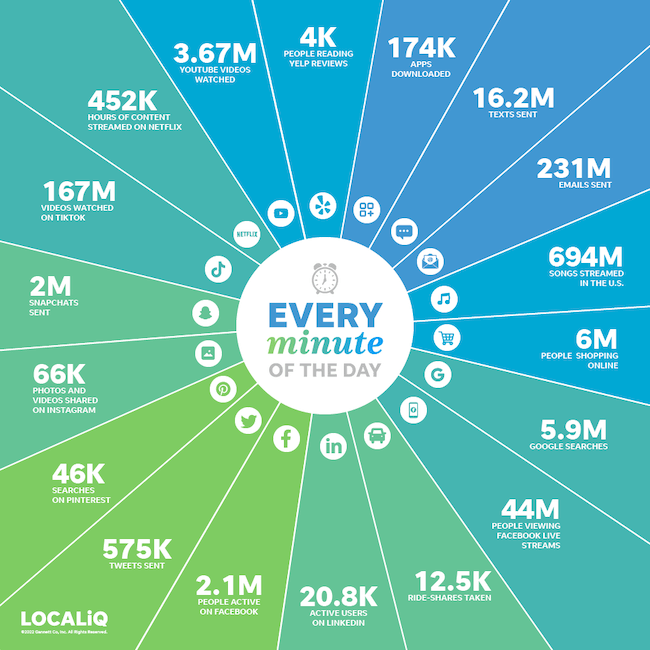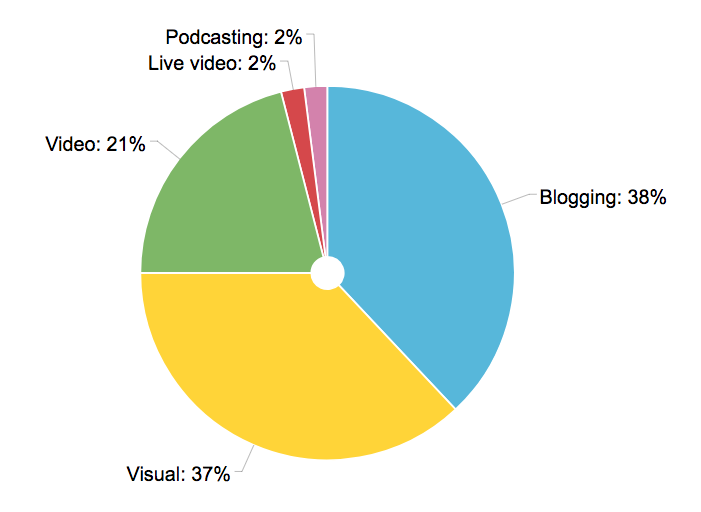You've heard it said that content is what fuels inbound marketing.
Hell, it's what fuels the internet! The world wide web exists for content. People wouldn't need internet connections if there were no content to consume. Websites, blogs, videos, social posts, wikis, cat GIFs — they’re the reason why the world is online.
As a marketer, you can leverage the world's insatiable appetite for content by producing material that people want and that showcases your brand at the same time. You know it's content that pulls in traffic. Content that transforms strangers into potential buyers. Content that drives purchase decisions.
The only problem is that there's a lot of it on the internet today.
According to LocaliQ, each minute of 2022 saw 3.7 million videos watched on YouTube, 2 million Snaps sent on SnapChat, 231 million emails sent, and 16.2 million text messages. It borders on the unfathomable.

Source: LocaliQ
As the contentverse gets more crowded, it becomes increasingly difficult for marketers to get their messages noticed, much less read. The competition you face to earn just a moment's attention is utterly ridiculous.
On top of this, content consumers are changing their habits. Old formats don't work anymore. Attention spans are getting shorter. People read less and skim more. They spend only seconds on a page before moving on to the next.
So, what are content marketers to do?
The best way to break through all the noise and get noticed is to create content that is snackable and highly visual. In other words, visual marketing is the way to go.
Visual snacks are the favorite food of modern internet users. They are more likely than any other type of content to drive engagement, get shared, and result in action.
But don't take my word for it. Social Media Examiner reports that 37% of marketers think that visuals are the most critical form of content for their business, second only to blogging. If you combine this with the 21% who said video (which you should), it would total 58%.

Source: SocialMediaExaminer
And if your peers’ consensus isn't enough, let's look at some of the research that underscores just how essential visual marketing is.
Why you need to use visual marketing
1. Humans are fundamentally lazy, and you should accommodate this.
It takes a lot of energy to activate your neocortex and process textual information. It's far easier to let your reptilian brain do the work instead. Our brains can process images up to 60,000 times faster than text — one reason why movies can move us to tears so much faster than novels can.
When you use visual content, you're making it easier for your audience to absorb and understand your value proposition. Processing an image takes far less energy, so viewers are more likely to pay attention. You should try to communicate your message with an image instead of a paragraph whenever you can.

2. The average visitor will read only 25% of your text
Sumo analyzed 650,000 articles and found that the average website visitor reads only about 25% of an article's text. The speed at which people browse through pages and articles, scanning for things that may interest them, makes it more essential than ever that you find a way to stop them in their tracks.
A carefully designed image can convey your message in less than a second — and the reality is that you only have a few seconds to grab your visitors' attention before they move on. Whether a compelling photo, a great video, or a well-designed infographic, using the right visual can make them pause and really look.
3. Without images, people will only remember 10% of what they read
Research compiled by John Medina reveals that those who hear or read a piece of information are likely to recall only about 10% three days later. However, if relevant imagery accompanies the same information, those people will remember about 65%. That's a big difference.
It's not difficult to find images that support the message you're trying to convey, and it's worth the effort. If you can match up your text with an appropriate photo, the chances that your message leaves a lasting impact will increase dramatically.

Tips for using visual content
The good news is that you don't need a team of professional designers to incorporate visual marketing into your mix (although it might help). There are many great tools that can help the average marketer create visually compelling content themselves.
Whether you have a professional design team at your disposal or not, these are some best practices you should abide by while creating visual content:
1. Keep it on topic. Images and other graphics should be relevant to your topic. They should add value to your content and reinforce your message. If you don’t stick to this rule, you risk letting your visuals become distractions instead of distinguishers.
2. Make it snackable. Always assume that your readers are lazy. Make things as easy as possible for them to digest. Use images to communicate instead of text wherever you can. Don’t produce infographics that require a significant amount of effort to interpret. Keep it bite-sized.
3. Stick to your house style. Applying your distinctive house style to all of your visual assets helps people recognize your brand. Sticking to your house fonts and colors will ensure people who remember your graphics also remember you when they encounter you elsewhere.
4. Repurpose content. Different types of visual content are suited to different audiences and platforms. You don’t have to produce something entirely unique for each one, though. Reuse the content from your infographic to create a SlideShare or a great YouTube video, for example.
5. Measure and improve. Whatever kind of content you produce, make sure to keep track of its performance. Testing variations and measuring engagement allows you to see what works best across various channels and continuously improve your strategy.
Incorporating more visual content into your marketing mix will help you stand out amidst all the surrounding noise. You’ll grab the attention of more users, you’ll increase engagement with your content, and you’ll leave an impression that lasts longer.
If done correctly, visual content won’t only fuel your inbound marketing efforts, it will fuel your bottom line results as well.


.png?width=527&name=Overcome-Content-Creation-Barriers%20(1).png)
